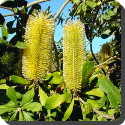 Banksia — Banksia is a genus of around 170 species in the plant family Proteaceae. Iconic Australian wildflower and popular garden plants, they are easily recognised by their characteristic flower spikes and fruiting “cones” and can vary from prostrate woody shrubs to trees up to 30 metres tall. They are generally found in a wide variety of landscapes; sclerophyll forest, (occasionally) rainforest, shrubland, and some more arid landscapes, though not in Australia’s deserts.
Banksia — Banksia is a genus of around 170 species in the plant family Proteaceae. Iconic Australian wildflower and popular garden plants, they are easily recognised by their characteristic flower spikes and fruiting “cones” and can vary from prostrate woody shrubs to trees up to 30 metres tall. They are generally found in a wide variety of landscapes; sclerophyll forest, (occasionally) rainforest, shrubland, and some more arid landscapes, though not in Australia’s deserts.
Heavy producers of nectar, banksias form a vital part of the food chain in the Australian bush. They are an important food source for all sorts of nectariferous animals, including birds, bats, rats, possums and a host of invertebrates. Furthermore, they are of economic importance to Australia’s nursery and cut flower industries. However these plants are threatened by a number of processes including land clearing, frequent burning and disease, and a number of species are rare and endangered.
Banksias grow as trees or woody shrubs. Trees of the largest species, B. integrifolia (Coast Banksia) and B. seminuda (River Banksia), often grow over 15 metres tall, and may be up to 30 metres tall. Banksia species that grow as shrubs are usually erect, but there are several species that are prostrate, with branches that grow on or below the soil.
The leaves of Banksia vary greatly between species. Sizes vary from the narrow, 1–1½ centimetre long leaves of B. ericifolia (Heath-leaved Banksia), to the very large leaves of B. grandis (Bull Banksia), which may be up to 45 centimetres long. The leaves of most species have serrated edges, but a few, such as B. integrifolia, do not. Leaves are usually arranged along the branches in irregular spirals, but in some species they are crowded together in whorls. Many species have differing juvenile and adult leaves (e.g. Banksia integrifolia has large serrated juvenile leaves).
Banksias are most easily recognised by their characteristic flower spike, known as an inflorescence, and the woody fruiting structures that appear after flowering. The flower spike consists of a central woody axis with a furry coating; it is generally held erect, but hangs down in a few species. This axis is covered in tightly-packed pairs of flowers, which are attached to the axis at right angles. A single flower spike generally contains hundreds, if not thousands of flowers. The most recorded is around 6000 individual flowers on inflorescences of B. grandis.
Banksias are popular garden plants in Australia because of their large, showy flower heads, and because the large amounts of nectar they produce attracts birds and small mammals. Popular garden species include B. spinulosa, B. ericifolia, B. aemula (Wallum Banksia ), B. serrata (Saw Banksia), Banksia media (Southern Plains Banksia) and the cultivar Banksia ‘Giant Candles’. Banksia species are primarily propagated by seed in the home garden as cuttings can be difficult to strike. However commercial nurserymen extensively utilize the latter method (indeed, cultivars by nature must be vegetatively propagated by cuttings or grafting).
 Kids Portal For Parents India Kids Network
Kids Portal For Parents India Kids Network






